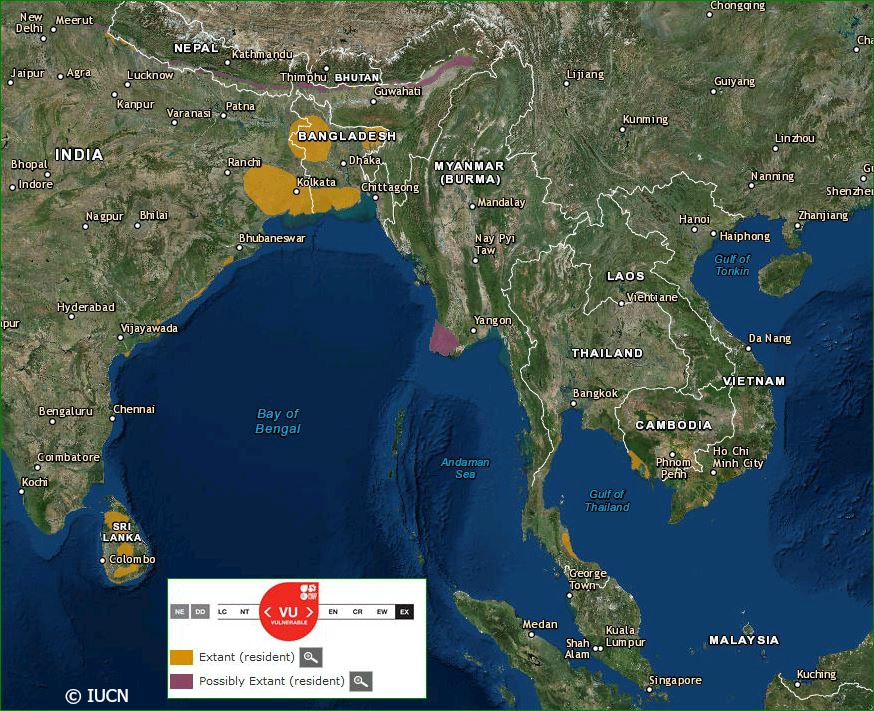
Unlike other cat species found around the world with the notable exception of the Jaguar the Fishing Cat spends most of its life in areas of dense vegetation close to water and is an excellent swimmer. You may notice that there is rarely a fish in the fishing cats.
Fishing cats have been reported in Himalayan forests at an elevation of 1525 m.
How do fishing cats live. Fishing cats are widely distributed but concentrated primarily in wetland habitats which are increasingly being settled degraded and converted. These cats are typically found in a number of water habitats including marshy thickets mangrove swamps and densely vegetated areas along rivers and streams. Fishing cats are relatively adaptable creatures and some live in city suburbs close to human settlements where there is little vegetation.
They communicate with guttural growls hisses and a low demanding meow. During courtship they make a sound that is called chittering. Fishing cats have such a large range as they live in mangroves which are far apart from each other.
They can be found in mangrove swamps which feature swamps rivers lakes reeds and marshes. Most of their habitats are in a forest with a stream so that they can fish. Fishing cats weigh between 13-26 pounds stand 15-16 inches tall and reach lengths of 38-47 inches.
Its coat is olive gray and is patterned with rows of parallel solid black spots which often form stripes along the spine. Their ears are short and round. HABITAT AND DIET Little is known about fishing cats in the wild but it is thought that they have no natural predators other than humans.
Fishing cats mainly eat fish but also dine on other prey found in the water including crabs crayfish and frogs. How fast can a fishing cat run. As nocturnal animals fishing cats are most active at night.
During the day guests can expect to see our cats napping on high perches they do love to climb exploring enrichment items and checking out guests through the exhibit window. You may notice that there is rarely a fish in the fishing cats. How to catch catfish in a lake.
Catfishing tips and techniques. Fishing for catfish with live bait. How to catch catfish with bluegill.
The Fishing Cat is a small to medium sized feline that is natively found throughout a number of countries in south-east Asia. Unlike other cat species found around the world with the notable exception of the Jaguar the Fishing Cat spends most of its life in areas of dense vegetation close to water and is an excellent swimmer. Well professionals like Peter Deeks do something DIFFERENT than you do out on the water when rigging live bait.
While many amateurs and weekend warriors run-and-gun to their favorite spot rigging up their baits as fast as possible without thinking through the situation pros like Peter are confidently rigging their baits quickly plucking. Fishing cats live primarily in wetland areas both marshes and swamps. These cats can be found in heavily forested regions adjacent to rivers or near jungles.
They can also be found in scrub areas reed beds and tidal creek areas. Fishing cats have been reported in Himalayan forests at an elevation of 1525 m. 5000 ft they have also been.
Fishing Cats live a solitary life that means they prefer to live alone except for the breeding season. During the breeding season male and female Fishing Cats come together for mating. After mating they go back to their territories and live a solo life.
Fishing Cats mark their territories and hunt in the shallow waters of those territories. Life in the mangroves of South Asia is difficult but theres one creature in this swamp thats defying the odds and our expectations at the same time. What do fisher cats eat.
Although fisher cat is a bit of a misnomer its not because the animals wont eat fish Joyce said but because they eat a lot of things and fish isnt usually at the. The great thing about Blue Cats is that theyre not as solitary as Flatheads. You can land huge numbers of them as well as individual giants.
This makes for a much more action-packed fishing trip. Blue Cats live in the same range as Flatheads but theyre usually limited to deeper waters in lakes and main river sections.